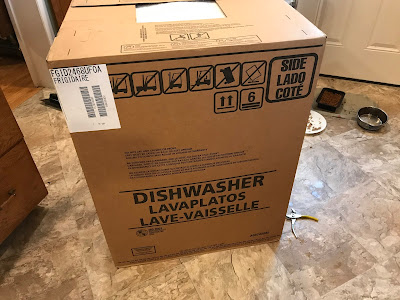Sunday, October 25, 2020
Dishwasher Autopsy
Sunday, October 18, 2020
A Simple Public Safety Radio Scanner with the Raspberry Pi - Landing on a Permanent Solution
Now that I finished my dishwasher installation, I was now able to swing my attention back to my scanner project.
Since I had now ruled out my Raspberry Pi Zero as a credible platform for my radio receiver, I had to take another look at my Raspberry Pi 4 as the foundation for my receiver.
The Pi 4 had certainly a lot more horsepower at its disposal and as an added bonus I also had a touch screen attached to it, so this gave me an opportunity to try to have some sort of display as part of the receiver, versus just having a plain box which was my original plan.
The first problem that I needed to attend to was the issue that drove me to the Pi Zero in the first place.
I needed to figure out some other way to get sound from the receiver without that infernal hissing noise that I had from the phono plug output when the receiver is waiting for radio transmissions.
The solution for that problem came to me rather by surprise during my last scouting mission at the neighborhood surplus store.
Sunday, October 11, 2020
Installing a Dishwasher
I had to take a bit of a break from the radio scanner project to attend to some urgent house "repairs".
Granted, with a family of four and both parents working, the dishwasher is in almost daily use, so it does get quite a workout at our house. But like clockwork, at the 5-year mark, it always starts getting a little tired, making very unpleasant noises, and the dishes almost seem to come dirtier than when they went in.
Inevitably, the cause of all the misery is some part that, when including the labor to install it, costs almost as much as what I had paid for the dishwasher originally.
This is all rather frustrating since I don't seem to have the same issue with the other appliances in the house. My washer and dryer are both pushing 20 years now and other than a new heating element for the dryer. they are both working well. The same goes for the fridge and stove. Yet I am looking at my 4th dishwasher since I bought my house.
On the bright side, I have gotten a bit of practice on installing dishwashers, so I can usually get a new one installed, up and running within a couple of hours.
So, with a brand new dishwasher sitting in a box in the middle of my kitchen, I started work.
Sunday, October 4, 2020
A Simple Public Safety Radio Scanner with the Raspberry Pi - Part 3 - Trying to Downsize
When I tried to run the SDR in "idle" mode by turning the squelch setting on the rtl_fm application way up, I was still getting a fairly load hissing noise coming from the speaker when I was fully expecting silence. The issue stemmed from the way the sound circuit is configured for the 3.5mm phono plug on the Pi. Due to the size and circuit restraints of the Pi, there isn't a "true" sound card running built-in, meaning that the sound will truly never be high quality. Apparently having a constant hiss when there is no audio output is quite common.
One option in resolving that is to plug in a dedicated USB soundcard which can be easily bought online for a few dollars, however, when I was doing my research I noticed that you could also use a Raspberry Pi Zero to create fairly decent audio by using its GPIO pins plugged into a pretty simple circuit (the Raspberry Pi Zero doesn't have a built-in sound port)
I actually liked the idea of using the Pi Zero since it would give me the opportunity to really reduce the size of my scanner. As luck should have it, I also had a Raspberry Pi Zero on hand.
To have the Pi Zero be able to connect to my amplifier, I needed to build an interface circuit that will act as a bridge between the Pi and the amp. This bridge, usually referred to as an audio HAT is actually a pretty common add on that you can buy from a lot of suppliers, however, when I came across a video by Tinkernut, I found that I could easily build my own audio HAT.




